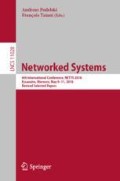Abstract
We consider the distributed setting of N autonomous mobile robots that operate in Look-Compute-Move cycles following the classic oblivious robots model. We study the fundamental problem where starting from an arbitrary initial configuration, N autonomous robots reposition themselves to a convex hull formation on the plane where each robot is visible to all others (the Complete Visibility problem). We assume obstructed visibility, where a robot cannot see another robot if a third robot is positioned between them on the straight line connecting them. We provide the first \(\mathcal{O}(N)\) time algorithm for this problem in the fully synchronous setting. Our contribution is a significant improvement over the runtime of the only previously known algorithm for this problem which has a lower bound of \(\varOmega (N^2)\) in the fully synchronous setting. The proposed algorithm is collision-free – robots do not share positions and their paths do not cross.
Access this chapter
Tax calculation will be finalised at checkout
Purchases are for personal use only
References
Di Luna, G.A., Flocchini, P., Poloni, F., Santoro, N., Viglietta, G.: The mutual visibility problem for oblivious robots. In: CCCG (2014)
Agathangelou, C., Georgiou, C., Mavronicolas, M.: A distributed algorithm for gathering many fat mobile robots in the plane. In: PODC, pp. 250–259 (2013)
Ando, H., Suzuki, I., Yamashita, M.: Formation and agreement problems for synchronous mobile robots with limited visibility. In: ISIC, pp. 453–460, August 1995
Choset, H., et al.: Principles of Robot Motion: Theory, Algorithms, and Implementations. MIT Press, Cambridge (2005)
Cohen, R., Peleg, D.: Robot convergence via center-of-gravity algorithms. In: Královic̆, R., Sýkora, O. (eds.) SIROCCO 2004. LNCS, vol. 3104, pp. 79–88. Springer, Heidelberg (2004). https://doi.org/10.1007/978-3-540-27796-5_8
Cohen, R., Peleg, D.: Local spreading algorithms for autonomous robot systems. Theor. Comput. Sci. 399(1–2), 71–82 (2008)
Cord-Landwehr, A., et al.: Collisionless gathering of robots with an extent. In: Černá, I., et al. (eds.) SOFSEM 2011. LNCS, vol. 6543, pp. 178–189. Springer, Heidelberg (2011). https://doi.org/10.1007/978-3-642-18381-2_15
Cord-Landwehr, A., et al.: A new approach for analyzing convergence algorithms for mobile robots. In: Aceto, L., Henzinger, M., Sgall, J. (eds.) ICALP 2011. LNCS, vol. 6756, pp. 650–661. Springer, Heidelberg (2011). https://doi.org/10.1007/978-3-642-22012-8_52
Cord-Landwehr, A., Fischer, M., Jung, D., Meyer auf der Heide, F.: Asymptotically optimal gathering on a grid. In: SPAA, pp. 301–312 (2016)
Czyzowicz, J., Gasieniec, L., Pelc, A.: Gathering few fat mobile robots in the plane. Theor. Comput. Sci. 410(6–7), 481–499 (2009)
Degener, B., Kempkes, B., Langner, T., Meyer auf der Heide, F., Pietrzyk, P., Wattenhofer, R.: A tight runtime bound for synchronous gathering of autonomous robots with limited visibility. In: SPAA, pp. 139–148 (2011)
Degener, B., Kempkes, B., Meyer auf der Heide, F.: A local o(n\({}^{\text{2}}\)) gathering algorithm. In: SPAA, pp. 217–223 (2010)
Di Luna, G.A., Flocchini, P., Chaudhuri, S.G., Poloni, F., Santoro, N., Viglietta, G.: Mutual visibility by luminous robots without collisions. Inf. Comput. 254, 392–418 (2017)
Flocchini, P., Prencipe, G., Santoro, N.: Distributed computing by oblivious mobile robots. Synth. Lect. Distrib. Comput. Theory 3(2), 1–185 (2012)
Izumi, T., Izumi, T., Kamei, S., Ooshita, F.: Feasibility of polynomial-time randomized gathering for oblivious mobile robots. IEEE Trans. Parallel Distrib. Syst. 24(4), 716–723 (2013)
Pagli, L., Prencipe, G., Viglietta, G.: Getting close without touching: near-gathering for autonomous mobile robots. Distrib. Comput. 28(5), 333–349 (2015)
Peleg, D.: Distributed coordination algorithms for mobile robot swarms: new directions and challenges. In: Pal, A., Kshemkalyani, A.D., Kumar, R., Gupta, A. (eds.) IWDC 2005. LNCS, vol. 3741, pp. 1–12. Springer, Heidelberg (2005). https://doi.org/10.1007/11603771_1
Sharma, G., Alsaedi, R., Busch, C., Mukhopadhyay, S.: The complete visibility problem for fat robots with lights. In: ICDCN, pp. 21:1–21:4 (2018)
Sharma, G., Busch, C., Mukhopadhyay, S.: Bounds on mutual visibility algorithms. In: CCCG, pp. 268–274 (2015)
Sharma, Gokarna, Busch, Costas, Mukhopadhyay, Supratik: Mutual visibility with an optimal number of colors. In: Bose, Prosenjit, Gasieniec, L., Römer, K., Wattenhofer, R. (eds.) ALGOSENSORS 2015. LNCS, vol. 9536, pp. 196–210. Springer, Cham (2015). https://doi.org/10.1007/978-3-319-28472-9_15
Sharma, G., Busch, C., Mukhopadhyay, S.: Brief announcement: complete visibility for oblivious robots in linear time. In: SPAA, pp. 325–327 (2017)
Sharma, G., Vaidyanathan, R., Trahan, J.L.: Constant-time complete visibility for asynchronous robots with lights. In: Spirakis, P., Tsigas, P. (eds.) SSS 2017. LNCS, vol. 10616, pp. 265–281. Springer, Cham (2017). https://doi.org/10.1007/978-3-319-69084-1_18
Sharma, G., Vaidyanathan, R., Trahan, J.L., Busch, C., Rai, S.: Complete visibility for robots with lights in O(1) time. In: Bonakdarpour, B., Petit, F. (eds.) SSS 2016. LNCS, vol. 10083, pp. 327–345. Springer, Cham (2016). https://doi.org/10.1007/978-3-319-49259-9_26
Sharma, G., Vaidyanathan, R., Trahan, J.L., Busch, C., Rai, S.: Logarithmic-time complete visibility for asynchronous robots with lights. In: IPDPS, pp. 513–522 (2017)
Vaidyanathan, R., Busch, C., Trahan, J.L., Sharma, G., Rai, S.: Logarithmic-time complete visibility for robots with lights. In: IPDPS.,pp. 375–384 (2015)
Yamashita, M., Suzuki, I.: Characterizing geometric patterns formable by oblivious anonymous mobile robots. Theor. Comput. Sci. 411(26–28), 2433–2453 (2010)
Author information
Authors and Affiliations
Corresponding author
Editor information
Editors and Affiliations
Rights and permissions
Copyright information
© 2019 Springer Nature Switzerland AG
About this paper
Cite this paper
Sharma, G., Busch, C., Mukhopadhyay, S. (2019). Complete Visibility for Oblivious Robots in \(\mathcal{O}(N)\) Time. In: Podelski, A., Taïani, F. (eds) Networked Systems. NETYS 2018. Lecture Notes in Computer Science(), vol 11028. Springer, Cham. https://doi.org/10.1007/978-3-030-05529-5_5
Download citation
DOI: https://doi.org/10.1007/978-3-030-05529-5_5
Published:
Publisher Name: Springer, Cham
Print ISBN: 978-3-030-05528-8
Online ISBN: 978-3-030-05529-5
eBook Packages: Computer ScienceComputer Science (R0)

